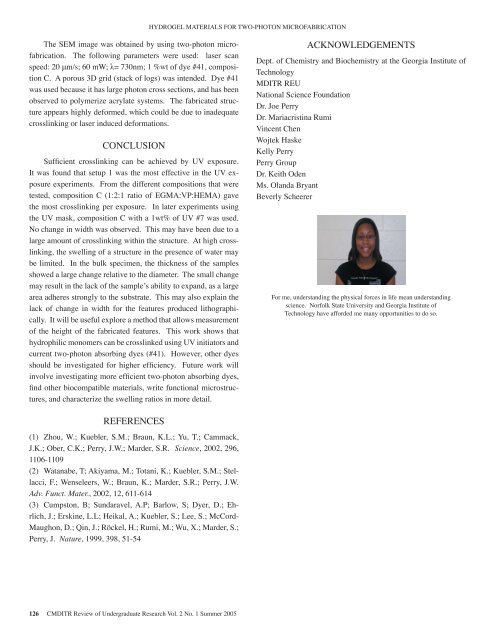Student Project Abstracts 2005 - Pluto - University of Washington
Student Project Abstracts 2005 - Pluto - University of Washington
Student Project Abstracts 2005 - Pluto - University of Washington
You also want an ePaper? Increase the reach of your titles
YUMPU automatically turns print PDFs into web optimized ePapers that Google loves.
HYDROGEL MATERIALS FOR TWO-PHOTON MICROFABRICATIONThe SEM image was obtained by using two-photon micr<strong>of</strong>abrication.The following parameters were used: laser scanspeed: 20 μm/s; 60 mW; λ= 730nm; 1 %wt <strong>of</strong> dye #41, compositionC. A porous 3D grid (stack <strong>of</strong> logs) was intended. Dye #41was used because it has large photon cross sections, and has beenobserved to polymerize acrylate systems. The fabricated structureappears highly deformed, which could be due to inadequatecrosslinking or laser induced deformations.CONCLUSIONSufficient crosslinking can be achieved by UV exposure.It was found that setup 1 was the most effective in the UV exposureexperiments. From the different compositions that weretested, composition C (1:2:1 ratio <strong>of</strong> EGMA:VP:HEMA) gavethe most crosslinking per exposure. In later experiments usingthe UV mask, composition C with a 1wt% <strong>of</strong> UV #7 was used.No change in width was observed. This may have been due to alarge amount <strong>of</strong> crosslinking within the structure. At high crosslinking,the swelling <strong>of</strong> a structure in the presence <strong>of</strong> water maybe limited. In the bulk specimen, the thickness <strong>of</strong> the samplesshowed a large change relative to the diameter. The small changemay result in the lack <strong>of</strong> the sample’s ability to expand, as a largearea adheres strongly to the substrate. This may also explain thelack <strong>of</strong> change in width for the features produced lithographically.It will be useful explore a method that allows measurement<strong>of</strong> the height <strong>of</strong> the fabricated features. This work shows thathydrophilic monomers can be crosslinked using UV initiators andcurrent two-photon absorbing dyes (#41). However, other dyesshould be investigated for higher efficiency. Future work willinvolve investigating more efficient two-photon absorbing dyes,find other biocompatible materials, write functional microstructures,and characterize the swelling ratios in more detail.ACKNOWLEDGEMENTSDept. <strong>of</strong> Chemistry and Biochemistry at the Georgia Institute <strong>of</strong>TechnologyMDITR REUNational Science FoundationDr. Joe PerryDr. Mariacristina RumiVincent ChenWojtek HaskeKelly PerryPerry GroupDr. Keith OdenMs. Olanda BryantBeverly ScheererFor me, understanding the physical forces in life mean understandingscience. Norfolk State <strong>University</strong> and Georgia Institute <strong>of</strong>Technology have afforded me many opportunities to do so.REFERENCES(1) Zhou, W.; Kuebler, S.M.; Braun, K.L.; Yu, T.; Cammack,J.K.; Ober, C.K.; Perry, J.W.; Marder, S.R. Science, 2002, 296,1106-1109(2) Watanabe, T; Akiyama, M.; Totani, K.; Kuebler, S.M.; Stellacci,F.; Wenseleers, W.; Braun, K.; Marder, S.R.; Perry, J.W.Adv. Funct. Mater., 2002, 12, 611-614(3) Cumpston, B; Sundaravel, A.P; Barlow, S; Dyer, D.; Ehrlich,J.; Erskine, L.L; Heikal, A.; Kuebler, S.; Lee, S.; McCord-Maughon, D.; Qin, J.; Röckel, H.; Rumi, M.; Wu, X.; Marder, S.;Perry, J. Nature, 1999, 398, 51-54126 CMDITR Review <strong>of</strong> Undergraduate Research Vol. 2 No. 1 Summer <strong>2005</strong>




